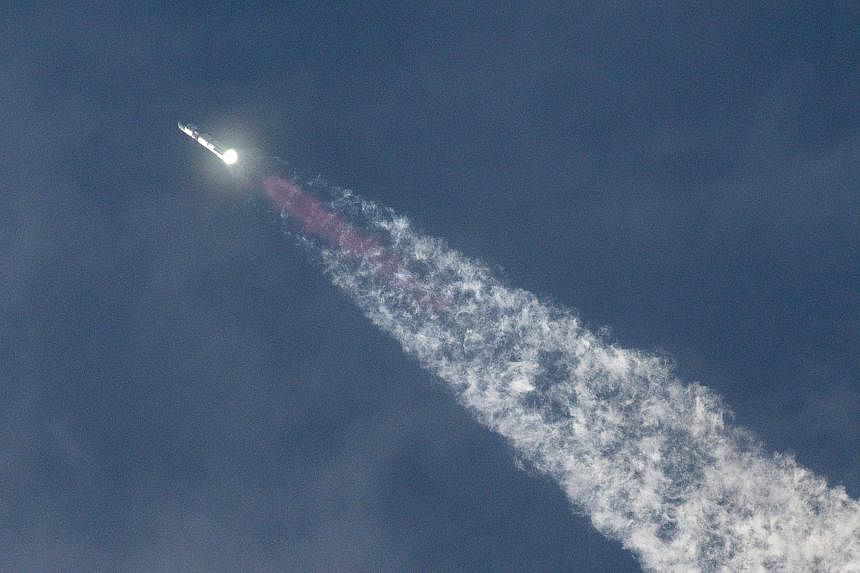BOCA CHICA, Texas – SpaceX’s Starship rocket, designed to eventually send astronauts to the moon and beyond, completed nearly an entire test flight on its third try on March 14, making it much farther than before with a cruise through low orbit before being destroyed during a return to Earth.
During a live webcast of the flight, SpaceX commentators said mission control lost communications with the spacecraft during its atmospheric re-entry. The vehicle was nearing a planned splashdown in the Indian Ocean about an hour after launch.
A few minutes later, SpaceX confirmed that the spacecraft had been lost, presumably either burning up or coming apart during re-entry or crashing into the sea.
Still, completion of most of the intended hour-plus test flight trajectory of Starship marked a major milestone in the development of a spacecraft crucial to billionaire Elon Musk’s satellite launch business and Nasa’s moon programme.
Nasa chief Bill Nelson congratulated SpaceX on what he called “a successful test flight” in a statement posted on the social media platform X.
The two-stage rocket ship, consisting of the Starship cruise vessel mounted atop its towering Super Heavy rocket booster, blasted off from the company’s Starbase launch site near Boca Chica on the Gulf Coast of Texas near Brownsville, on an uncrewed flight to space.
During its flight, Starship reached peak altitudes of 234km, the company said.
SpaceX engineers had hoped to improve on the Starship’s two past performances, which both ended in explosions minutes after launch, although the company had acknowledged in advance a high probability that its latest flight might similarly end with the spacecraft’s destruction before the planned mission profile was finished.
A live SpaceX webcast of the lift-off showed the rocket ship rising from the launch tower into the morning sky as the Super Heavy’s cluster of powerful Raptor engines thundered to life in a ball of flame and billowing clouds of exhaust and water vapour.
The launch came less than 24 hours after federal regulators granted SpaceX a launch licence for the test.
Unlike the first two test flights in 2023, aimed mainly at demonstrating that the spacecraft’s two stages can separate after launch, plans for the March 14 test called for an attempt to open Starship’s payload door and reignite one of its engines in space.
Regardless of how well it performed on March 14, all indications are that Starship remains a considerable distance from becoming fully operational.
Mr Musk, SpaceX’s founder and CEO, has said the rocket should fly hundreds of uncrewed missions before carrying its first humans. And several other ambitious milestones overseen by Nasa are needed before the craft can execute a moon landing with American astronauts.
Musk’s goal
Still, Mr Musk is counting on Starship to fulfil his goal of producing a large, multipurpose next-generation spacecraft capable of sending people and cargo to the moon later this decade, and ultimately flying to Mars.
Closer to home, Mr Musk also sees Starship as eventually replacing the SpaceX Falcon 9 rocket as the workhorse in the company’s commercial launch business that already lofts most of the world’s satellites and other payloads to low-Earth orbit.
For the third launch, SpaceX was aiming to at least exceed Starship’s performance with its Super Heavy booster during their inaugural test launch together last April, when the spacecraft exploded over the Gulf less than four minutes into a planned 90-minute flight.
That flight went awry from the start. Some of the Super Heavy’s 33 Raptor engines malfunctioned on ascent, and the lower-stage rocket failed to separate as designed from the upper-stage Starship, leading to termination of the flight.
The second test flight in November made it farther than the first, and managed to properly achieve stage separation, but the spacecraft exploded about eight minutes after launch.
SpaceX’s engineering culture, considered more risk-tolerant than many of the aerospace industry’s more established players, is built on a flight-testing strategy that pushes spacecraft to the point of failure, then fine-tunes improvements through frequent repetition.
Nasa, SpaceX’s biggest customer, has a lot riding on the success of Starship, which the US space agency is giving a central role in its Artemis programme, successor to the Apollo missions that put astronauts on the moon for the first time more than 50 years ago.
While Mr Nelson, the Nasa chief, has embraced Mr Musk’s frequent flight-testing approach, agency officials in recent months have made clear their desire to see greater progress with Starship’s development as the United States races with China to the lunar surface. REUTERS

